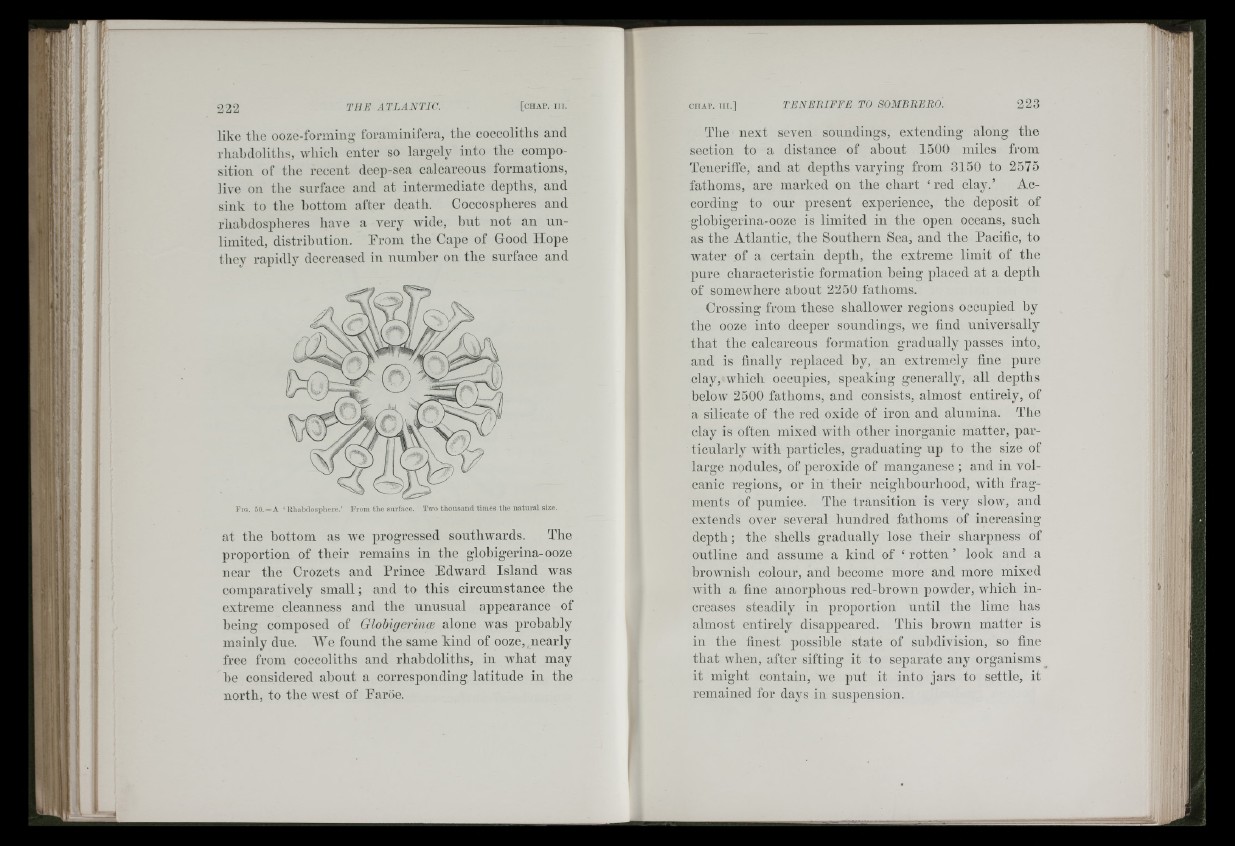
’Si
li
\ i
.
\ ’
H
” 1
s':
k li-.
222 THE A T LA N T IC . [ c h a p . I I I .
like the ooze-forming' foraminifera, the coccoliths and
rhahdoliths, which enter so largely into the composition
of the recent deep-sea calcareous formations,
live ou the surface aud at intermediate depths, aud
sink to the bottom after death. Coccospheres and
rhabdospheres have a very wide, but not an unlimited,
distribution. Erom the Cape of Good Hope
tliey rapidly decreased iu number on the surface and
Fro. 50. —A ‘ Rhabdospliere.' From the surface. Two thousand times the n a tu ra l size.
at the hottom as we progressed southwards. The
proportion of their remains in the globigerina-ooze
near the Crozets and Prince Edward Island was
comparatively small; and to this circumstance the
extreme cleanness and the unusual appearance of
heing composed of Glohigerince, alone was probably
mainly due. We found the same Idnd of ooze, nearly
free from coccoliths and rhabdoliths, in what may
he considered about a corresponding latitude in the
north, to tlie Avest of Faroe.
The next seven soundings, extending along the
section to a distance of about 1500 miles fi'om
Teueriffe, and at depths varying from 3150 to 2575
fathoms, are marked ou the chart ‘ red elay.’ According
to our present experience, the deposit of
glohigerina-ooze is limited iu the open oceans, such
as the Atlantic, the Southern Sea, and the Pacific, to
Avater of a certain depth, the extreme limit of the
pure characteristic formation being placed at a depth
of someAvliere ahout 2250 fathoms.
Crossing from those shalloAA'cr regions occupied by
the ooze into deeper soundings, we find universally
that the calcareous formation gradually passes into,
and is finally replaced by, an extremely fine pure
clay, Avhich occupies, speaking generally, all depths
beloAV 2500 fatlioms, and consists, almost entirely, of
a silicate of the red oxide of iron and alumina. Tbe
clay is often mixed Avith other inorganic matter, particularly
Avith particles, graduating up to the size of
large nodules, of peroxide of manganese ; and in volcanic
regions, or iu their neighhourhood, Avitli fragments
of pumice. The transition is very slow, aud
extends OA'er several hundred fathoms of increasing
depth; tlie shells gradually lose their sharpness of
outline and assume a kind of ‘ rotten ’ look and a
broAA'uish colour, and become more and more mixed
Avith a fine amorphous red-broAvii poAvder, wliich increases
steadily in proportion until the lime has
almost entirely disappeared. This broAvn matter is
in the finest possible state of subdivision, so fine
that Avhen, after sifting it to separate any organisms
it might contain, Ave put it into jars to settle, it
remained for days in suspension.
I
um
ir ’ ' I
, 'fffi